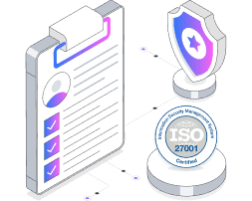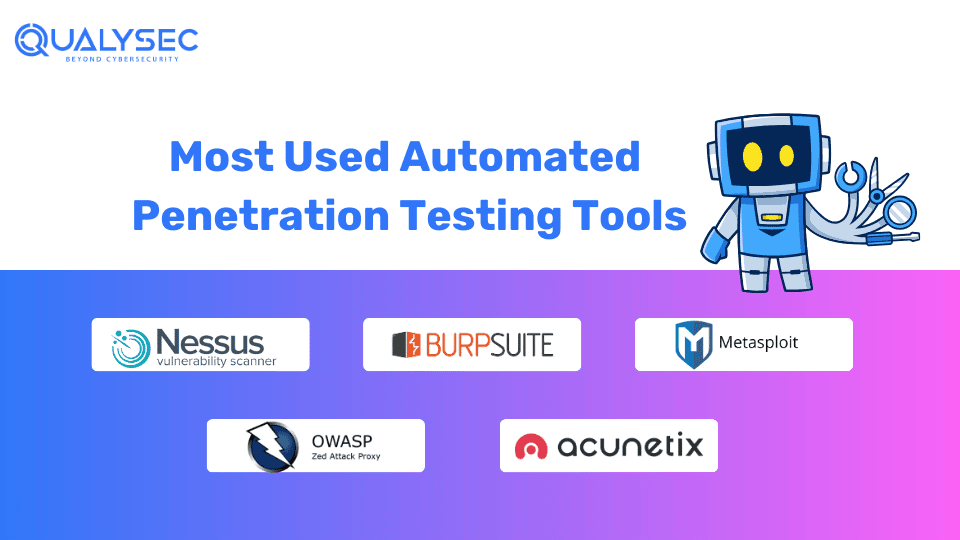Cybersecurity has emerged as a significant business issue in the current digital environment. The methods for protecting against cyberattacks must also advance with the challenges. Traditionally, penetration testing has been a manual process used to simulate a cyberattack to assess the security of an IT infrastructure.
However, technological improvements have made automated pentesting an effective way to improve security protocols. This blog covers the advantages, features, and comparisons between automated and manual penetration testing.
An Introduction to Automated PenTesting
An approach for finding and exploiting weaknesses in an organization’s IT infrastructure is automated pentesting, which uses software tools. When doing security assessments, automated tools adhere to pre-established protocols and algorithms, compared to manual testing, which depends on the experience and judgment of human testers. By thoroughly assessing potential security flaws, these tools can examine systems, networks, and apps for vulnerabilities.
Automated tools for penetration testing can carry out several tasks, including post-exploitation analysis, exploit attempts, and vulnerability detection. To find vulnerabilities before they may be taken advantage of in actual situations, experts imitate the activities of malicious attackers. This method guarantees a regular and thorough evaluation of an organization’s security posture while saving time and money.
Differences Between Automatic & Manual Penetration Testing
Both manual and automated pentesting seeks to find security flaws, but their methods and conclusions differ significantly.
Automated PenTesting
| Speed and Efficiency | Compared to manual testing, automated tools can take tests and scan large networks and systems within the shortest duration. |
| Consistency | Automated testing replicates the results of earlier tests and follows set protocols and procedures. |
| Scalability | These tools do not require additional human effort to test a large and complex environment because they are scalable. |
| Cost-Effective | Automating the penetration testing process means it becomes free from high human interjection. Therefore, it reduces the cost of penetration testing. |
Manual PenTesting
| Creativity and Intuition | Manual penetration testing is conducted by people who, unlike a tool, can learn new approaches outside of a program and apply them to uncover defects. |
| Contextual Understanding | Manual testers must be able to see the big picture of the situation that surrounds them, which can assist in identifying risks to the operations of the organization and the overall risk potential of the general environment. |
| Customization | Manual testing can focus on the given organization’s particular context, which can be advantageous and helpful. |
| Exploit Verification | Automated tools may not detect some vulnerabilities, but they are easily detected by a human tester, which makes them the second-best. |
Click here to learn more about the automated pen test report and how testers may help you improve your application’s security.
Latest Penetration Testing Report

Advantages and Challenges of Automated PenTesting
Advantages
| Time-Efficiency | Automated pentesting is faster in terms of time than manual testing; it can scan and test systems quickly. |
| Continuous Monitoring | Once configured, these tools can be run continually, which gives constant reports and notifications for new threats. |
| Comprehensive Coverage | Using automated tools is very effective because they can analyze various security aspects, meaning that no aspect of the attack will go unnoticed. |
| Cost-Effective | Automated testing is a cost-effective solution for frequent security audits, as it minimizes the need for significant human input. |
Challenges
| False Positives | Automated tools may produce false positive results, which may be misleading and take time and effort. |
| Limited Contextual Understanding | They do not possess the contextual understanding of human testers and may fail to detect specific weaknesses. |
| Dependency on Predefined Scripts | Automated testing is based on a set of scripts and rules that might not contain all variants of attacks. |
| Complex Environments | Complex or unique configurations could also be a problem for the automation procedures and need to be addressed manually for an appropriate evaluation. |
Checks Performed by Automated PenTesting
Numerous tests are carried out by automated pentesting programs to find potential security flaws. Here are a few of the essential checks:
1. Vulnerability Scanning:
Automated vulnerability scans compare network, application, and system configurations to databases of known vulnerabilities, such as the Common Vulnerabilities and Exposures (CVE) list. This method detects vulnerabilities attackers could exploit, ensuring that systems are updated with security patches.
2. Configuration Audits:
Automated pentesting programs conduct configuration audits to detect errors in system settings. Misconfigured systems might introduce vulnerabilities, such as open ports or inadequate authentication techniques, that attackers can exploit. Ensuring suitable configurations improves overall system security while reducing potential attack surfaces.
3. Web Application Testing:
Automated tools scan online applications for vulnerabilities like SQL injection, cross-site scripting (XSS), and improper authentication. These tests simulate common attack vectors in web applications to uncover vulnerabilities attackers could exploit, assisting developers in securing their code and infrastructure.
4. Network Security:
Automated network security evaluations include scanning for open ports, unencrypted communications, and other vulnerabilities in network settings. These tests assist in identifying weak places in network defenses that could allow unauthorized access, ensuring that strong security measures are in place to protect sensitive data.
5. Password Attacks:
Automated pentesting tools perform password attacks, such as guessing or brute force attacks, to assess the strength of the system’s passwords. This approach aids in the identification of weak or readily guessable passwords, encouraging the implementation of tighter password regulations to increase security.
Does Automated PenTesting Offer Enough Protection?
Automated pentesting provides an outstanding platform for detecting and addressing security flaws. However, it should not be considered an independent solution. While automation improves speed, economy, and consistency, it lacks the depth of analysis that human testers provide.
A comprehensive security strategy should include both automated and manual penetration tests. Automated technologies can manage routine and large-scale evaluations, continuously scanning for new vulnerabilities. Meanwhile, manual testing should be used for in-depth analysis, personalized assessments, and situations necessitating human intuition and creative thinking.
By combining automated and human procedures, companies can develop a balanced and effective security posture that provides comprehensive protection against various threats.
Tools for Automated PenTesting
Several tools are available for automated pentesting, each with features and capabilities. Some of the most commonly used tools include:
1. Nessus
An open-source vulnerability scanner intended to detect hazards, configuration errors, and noncompliance with security regulations in IT environments. It delivers extensive evaluations, which aid in detecting vulnerabilities that attackers could exploit, and detailed reports to help mitigate any risks.
2. Burp Suite
A powerful tool for web application security testing that combines automatic and manual methods to detect vulnerabilities. It enables in-depth analysis with functions such as scanning, crawling, and testing, making it an indispensable tool for penetration testers seeking to ensure complete security evaluations of web applications.
3. Acunetix
An online application scanner designed to detect a wide range of vulnerabilities, including SQL injection and cross-site scripting. It conducts extensive crawling and scanning to find vulnerabilities, delivering deep insights and remedial guidance to improve the security posture of web applications.
4. Metasploit
A penetration testing framework that mimics hacker attacks to identify system flaws. It offers an extensive collection of modules for various vulnerabilities and payloads, allowing testers to conduct targeted attacks and assess security defenses in a controlled environment.
5. OWASP ZAP
An open-source tool for finding security flaws in web applications. It includes automated scanners and manual testing tools, making it adaptable to various testing scenarios. Security professionals frequently use ZAP to verify online applications resist typical threats.
Does your business require automated pentesting of applications? Get a free consultation with one of our skilled security specialists right now!
Talk to our Cybersecurity Expert to discuss your specific needs and how we can help your business.
Conclusion:
Automated pentesting is a crucial part of recent cybersecurity strategies. It provides various advantages, including speed, efficiency, and extensive coverage, making it an indispensable tool for enterprises looking to defend their IT infrastructure. However, automated testing should not be considered a replacement for manual testing. Instead, a hybrid strategy that combines the benefits of automated and manual testing can provide the most effective defense against cyber-attacks.
Organizations integrating automated technologies into their security operations can continuously monitor for vulnerabilities, assuring early discovery and risk reduction. Meanwhile, manual testing provides the depth and context required for comprehensive security assessments. These measures can help organizations maintain a secure and flexible security posture in an ever-changing threat environment.
FAQs:
Q. What is automated vulnerability testing?
A. Automated vulnerability testing involves the use of software tools to detect, assess, and report security flaws in applications, systems, or networks. It automates the detection process, resulting in complete and consistent security assessments with no manual intervention.
Q. What are the four main types of vulnerability?
A. The four main types of vulnerabilities are:
- Network Vulnerabilities
- Operating System Vulnerabilities
- Process Vulnerabilities
- Human Error Vulnerabilities
Q. What are the different types of vulnerability testing?
A. Vulnerability testing encompasses network scanning, penetration testing, ethical hacking, application security testing, security audits, vulnerability assessments, and configuration management. Each kind focuses on detecting and addressing security flaws in networks, systems, applications, and configurations.
Top Company Choose Qualysec for their Pentesting need










































































































































































































































































































































0 Comments